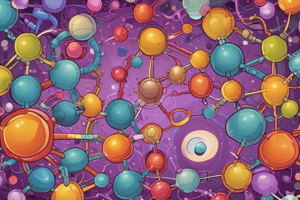Podcast
Questions and Answers
What is the common feature of lipids that defines them as a group?
What is the common feature of lipids that defines them as a group?
- Solubility in water
- Insolubility in water (correct)
- Reactivity with oxygen
- Solubility in non-polar solvents
What is the function of fatty acid carbon atom numbering?
What is the function of fatty acid carbon atom numbering?
- To specify the position of the double bond
- To establish the parent hydrocarbon name (correct)
- To determine the degree of unsaturation
- To identify the carboxylic acid group
What is the term for a C18 fatty acid with one double bond?
What is the term for a C18 fatty acid with one double bond?
- Octadecadienoic
- Octadecane
- Octadecanoic
- Octadecenoic (correct)
What is the significance of lipids' water-insolubility in the body?
What is the significance of lipids' water-insolubility in the body?
What is the role of lipids in the cell's energy economy?
What is the role of lipids in the cell's energy economy?
What is the characteristic of the terminating group of fatty acids?
What is the characteristic of the terminating group of fatty acids?
What type of fatty acid has no double bonds and carries the maximum possible number of hydrogen atoms?
What type of fatty acid has no double bonds and carries the maximum possible number of hydrogen atoms?
What is the difference between cis and trans fatty acids?
What is the difference between cis and trans fatty acids?
What is the function of triglycerides in metabolism?
What is the function of triglycerides in metabolism?
What is the difference between essential and non-essential fatty acids?
What is the difference between essential and non-essential fatty acids?
What is the structure of a phospholipid?
What is the structure of a phospholipid?
What is the name of the phospholipids derived from glycerol?
What is the name of the phospholipids derived from glycerol?
What is the main characteristic of glycolipids?
What is the main characteristic of glycolipids?
In which tissue is cerebroside primarily found?
In which tissue is cerebroside primarily found?
What is the orientation of the cholesterol molecule in membranes?
What is the orientation of the cholesterol molecule in membranes?
What is the structural feature of cholesterol?
What is the structural feature of cholesterol?
What is the origin of bile salts?
What is the origin of bile salts?
What is the normal range for High-Density Lipoprotein Cholesterol (HDL-C)?
What is the normal range for High-Density Lipoprotein Cholesterol (HDL-C)?
Flashcards are hidden until you start studying
Study Notes
Fatty Acids
- Fatty acids with no double bonds are saturated, carrying the maximum possible number of hydrogen atoms (Example: Stearic Acid)
- Fatty acids with at least one double bond are unsaturated, lacking hydrogen atoms (Example: Linoleic Acid)
- Cis fatty acids have hydrogen atoms on the same side of the double bond
- Trans fatty acids have hydrogen atoms on opposite sides of the double bond
Essential/Non-Essential Fatty Acids
- Non-essential fatty acids are produced by the body
- Essential fatty acids are derived from diets and are necessary for vital functions (Examples: Linoleic (C18:2 ω6) and α-Linolenic (C18:3 ω3))
Triglycerides
- Triglycerides are formed from a molecule of glycerol and three fatty acids
- Triglycerides are major components of VLDL and chylomicrons
- Triglycerides are important in metabolism as energy sources and transporters of dietary fat
Phospholipids
- Phospholipids contain one or more fatty acids attached to a phosphate and an alcohol
- Phospholipids may be attached to glycerol or sphingosine
- Phospholipids derived from glycerol are called phosphoglycerides
Lipids
- Lipids are a chemically diverse group of organic compounds, defined by their insolubility in water
- Lipids are highly soluble in non-polar solvents (Chloroform and ether)
- Lipids' water-insolubility contributes to the complexity in their digestion, transport, and metabolism
Types of Lipids
- Fatty acids are long hydrocarbon chains with various lengths and degrees of unsaturation, terminating with carboxylic acid groups
- Fatty acids' carbon atoms are numbered starting at the carboxyl terminus
- The systematic name is derived from the parent hydrocarbon's name, substituting "oic" for the final "e"
- Examples: octadecanoic acid (C18 saturated fatty acid), octadecenoic acid (C18 fatty acid with one double bond), cardiolipin (found in the heart), and sphingomyelin (found in the brain)
Glycolipids
- Glycolipids are sugar-containing lipids derived from sphingosine
- Glycolipids differ from sphingomyelin in the identity of the unit linked to the primary hydroxyl group of the sphingosine backbone
- Examples: cerebroside (simplest glycolipid, found in neural tissue, contains a sugar residue of glucose or galactose)
Sterol Lipids
- Cholesterol is built from 4 linked hydrocarbon rings, with a hydrocarbon tail linked to the steroid at one end and a hydroxyl group attached at the other end
- In membranes, the orientation of cholesterol is parallel to the fatty acid chains of phospholipids, and the hydroxyl group interacts with nearby phospholipid head groups
- Bile salts have the 4 linked hydrocarbon rings plus taurine, glycine, or both (example: originates from cholesterol)
Lipid Profile
- High-density lipoprotein cholesterol (HDL-C): >1.2mmol/l
- Low-density lipoprotein cholesterol (LDL-C): 2.4mmol/l
- Triglyceride
Studying That Suits You
Use AI to generate personalized quizzes and flashcards to suit your learning preferences.




